Aston Martin DB5 Vantage came in three forms: we try Saloon, Convertible and ’Brake
How would you like your DB5 Vantage: Saloon, Convertible or Shooting Brake? Or, if you’ve got a cool £4m sitting around, you could buy all three. We drive them — and fantasise about that Lottery win.
COVER STORY: DB5 TRINITY
- The DB5 Vantage came in three forms: we try Saloon, Convertible and ’Brake
It’s not often that a DB5 Vantage coupé in gleaming Silver Birch is the least remarkable car in a group of three, but in this exalted company the coupé – or Saloon in period Aston parlance – is very much the common or garden variety, as a glance at the build numbers will confirm. The silver car is one of only 60 DB5 Vantage coupés built in period, but that’s positively commonplace compared with the Convertible, of which just five (or possibly six) were made to Vantage spec. Five? Pfft. If you want real exclusivity you need to direct your attention to the DB5 Vantage Shooting Brake. Specifically, the car you see here. The one and only ’Brake that was equipped with the more powerful Vantage engine in period.
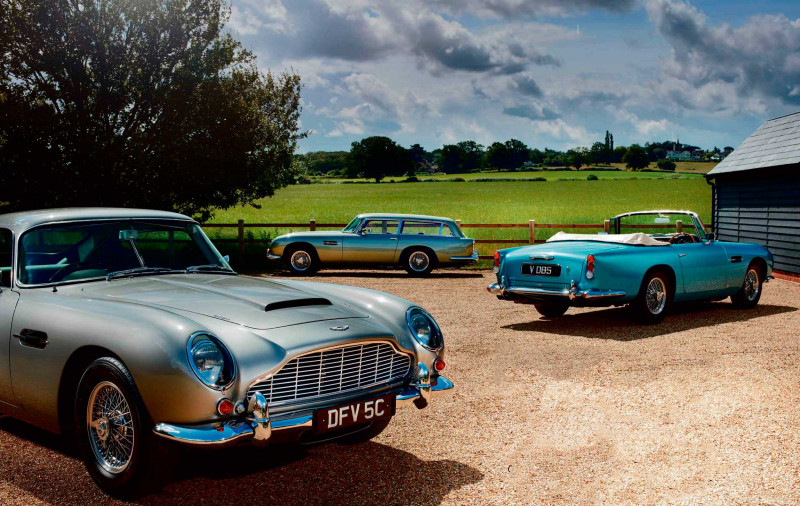
These tiny numbers explain the one very large number attached to these three cars should you wish to buy them as a set. As currently offered by Hatfield-based specialist Nicholas Mee & Co, the ‘DB5 Vantage Icons Collection’ has a £4 million price tag attached. That’s a lot of money, but then if you tot up the values of the three cars individually (coupé probably knocking on £750,000, Convertible possibly £1.5 million, Shooting Brake… well, we’re into really rarefied air here) then it doesn’t seem that astronomical. And they genuinely are a ‘collection’, in as much as they were brought together over the last decade or so by one individual, a Yorkshire-based enthusiast of means who entrusted each in turn to Otley-based Aston specialist Adrian Johnson for a full restoration. Which explains why the colours complement each other so well, in addition to each shade being wholly appropriate for each individual model. Silver Birch is the obvious choice for a DB5 coupé, but Caribbean Pearl is perfect for the glamorous Convertible and California Sage suits the Shooting Brake right down to the ground.
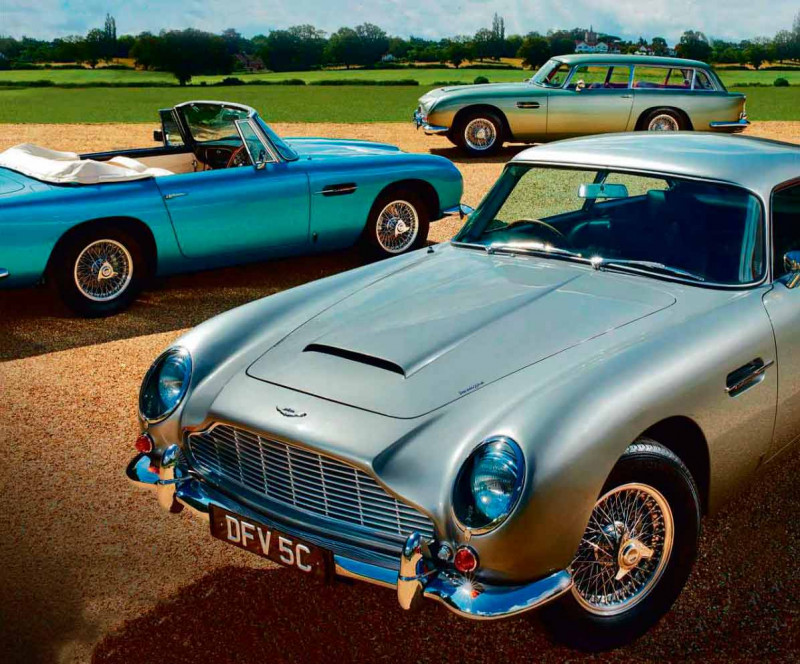
Together, they look simply dazzling. But even so, four million? Nick Mee sees it like this: ‘If you set out to collect all three Vantage models, you might find a coupé; you’d probably struggle to find a Convertible, and if you want a DB5 Vantage Shooting Brake, well, this is the only one.
‘The Shooting Brake is the real star here. To slip behind the wheel is a genuine privilege’

‘Can you think of a cooler car to transport family and hampers to the Goodwood Revival?’
‘We believe the cars have value as a collection, so that’s how we’re presenting them – it would be nice if they stayed together. There are some very wealthy individuals out there who are looking to invest large sums of money and hopefully get some pleasure from it at the same time.
‘You can never underestimate the value of the Vantage name. And it’s not just the extra power, it’s the low numbers, too. Even James Bond’s DB5 wasn’t a Vantage…’

Left and right Each Shooting Brake started life as a coupé; conversion was by coachbuillder Harold Radford. One useful plus for rear-seat passengers was improved headroom compared with the coupé. Seat-backs could be folded flat for load-carrying.
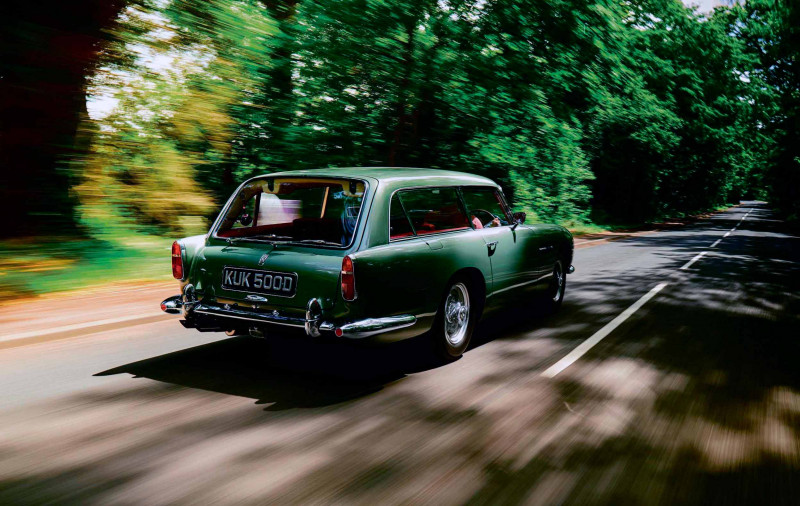
Launched in July 1963, the DB5 was distinguished from late versions of the DB4 chiefly by the introduction of a 4.0-litre version of the all-alloy Marek straight-six in place of the 3.7 and the option of a five-speed ZF gearbox (quite a novelty at the time) that quickly became standard equipment instead of the David Brown four-speeder. Power in standard form with triple SU carburettors was quoted as 282bhp. Choose the Vantage option and you got Triple Weber 45DCOEs and a claimed 314bhp.
The coupé here was originally painted Black Pearl and had a very active early life racing and hillclimbing; period photos show it with mildly flared wheelarches; other pics show that it had a silver roof for a while – and now it’s fully silver and considerably better than new after its restoration by Adrian Johnson and his team. A Convertible version – not yet called a Volante at this stage – joined the DB5 range soon after the launch of the Saloon but was always a rare machine. A grand total of 123 were sold, of which a mere handful had the Vantage engine, our car being one of that select group.
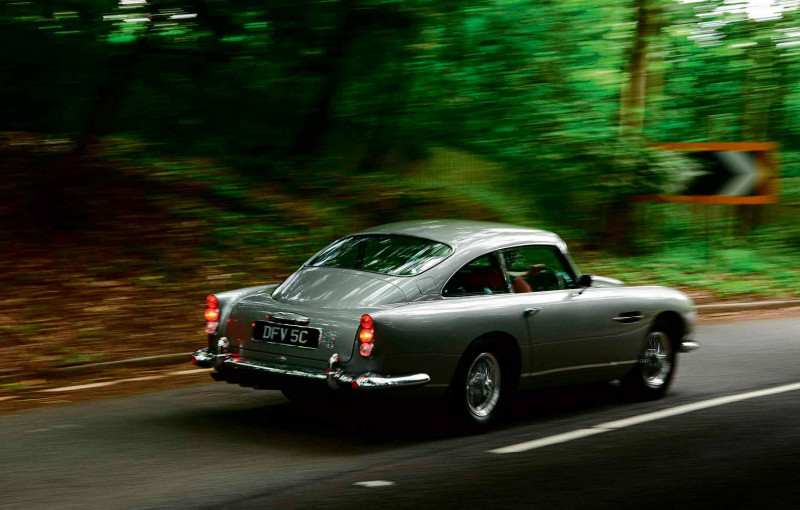
The car that intrigues the most, though, is the Shooting Brake, a real unicorn among Astons. The model came about because David Brown himself needed space to carry his sporting paraphernalia – he was a keen polo player and huntsman – and so asked the factory at Newport Pagnell to create a DB5 ’Brake for his own personal use. When customers and business associates saw the result, a number decided they’d like one, too. But the factory was already at full stretch building Saloons and Convertibles, so Brown did a deal with Hammersmith-based Harold Radford Ltd to body the estate version. It was advertised as ‘The World’s Fastest Dual Purpose Vehicle’.
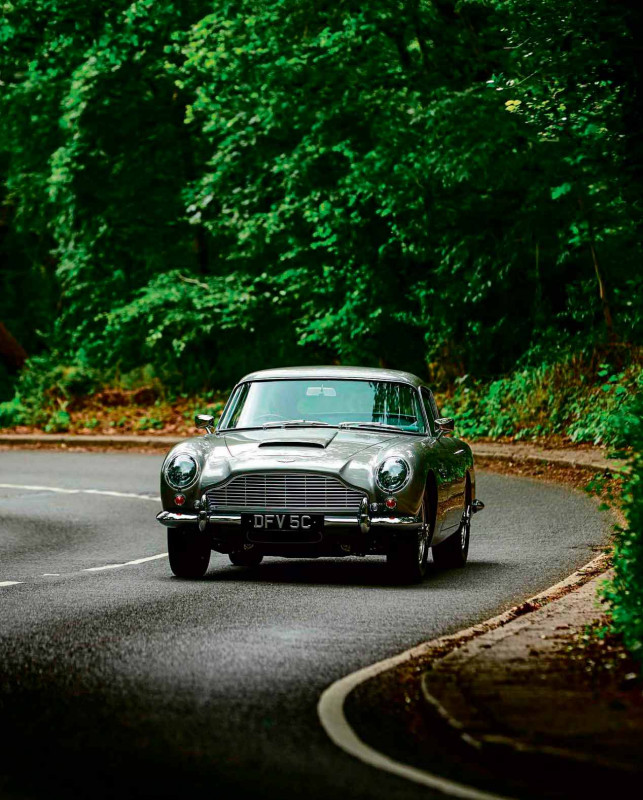
‘In the coupé you focus on the business of making swift progress with economy of effort’
Each ’Brake began its life as a completed coupé, which meant extensive reworking of the upper structure and body – basically everything from the A-pillars backwards. The work added a daunting 50 per cent to the already formidable price of the coupé, which probably explains why only 12 were built. And this particular example, as we know, was the only one of those 12 with the rortier, Weber equipped Vantage engine.
KUK 500D was commissioned by dealer Cyril Williams of Wolverhampton and delivered to a hotel in Pembrokeshire in 1966. By coincidence, while it was supplied in Caribbean Pearl, the pre-conversion donor Saloon had been painted California Sage – the colour the ’brake wears today. Originally it had an auto gearbox, but long-term owner Roy Smith converted it to a ZF manual in the early 1990s.

Left and right Key difference with the Vantage version was the fitment of triple Weber carburettors in place of the standard car’s SUs, lifting the stated power output from 282 to 314bhp, though both figures were probably more than a touch optimistic. Only 65 coupés had the option.
It’s a lovely thought that in its early life it might have been used to collect hotel guests and their luggage from the local train station. Which would, of course, have made it a station wagon as well as a shooting brake.
It’s an elegant conversion in the metal. The lines might not be quite as easy on the eye as those of the coupé and Convertible, but there’s something undeniably cool about the Shooting Brake, that combination of performance and utility. It’s a genuinely practical machine, too. There’s more headroom for rear-seat passengers than in a coupé, and opening the single-piece tailgate reveals a decent load area for weekend luggage – or a brace of Purdeys and a spaniel or two. Flip the rear seat-backs down and there’s even more.
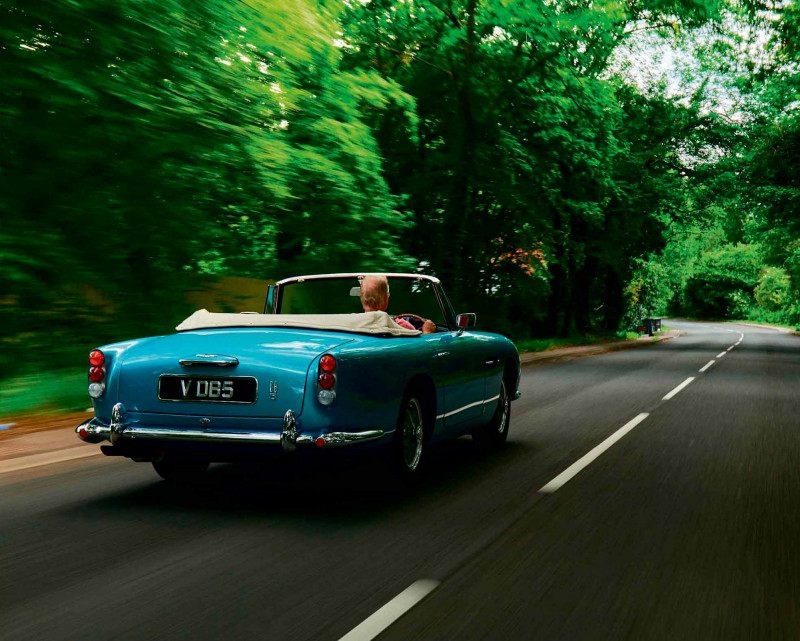
An endearing touch is the pair of dinky windscreen wipers on the rear screen. Not all DB5 ’brakes had them, and they do look a little Heath Robinson, but I don’t doubt that they served a function since the tailgate was bound to be a magnet for muck. Not that this ’Brake is likely to see much use in filthy weather conditions these days…
‘You can forgive a car the odd wobble when it looks as gorgeous as a DB5 Vantage Convertible’
Happily, for the day of our shoot, we’re blessed with high clouds and the odd burst of sunshine. Time to slip into the driver’s seats of this remarkable trio of DB5s and start daydreaming about that Lotto win.
Now, the driving element of this feature was always going to be limited in scope. In terms of dynamics, we knew that each car would feel broadly similar to the next, and, much as we love the DB5, back-to-back in-depth road tests of all three variants would hardly make for compelling copy.
‘Just five (or possibly six) Convertibles were made to Vantage specification’
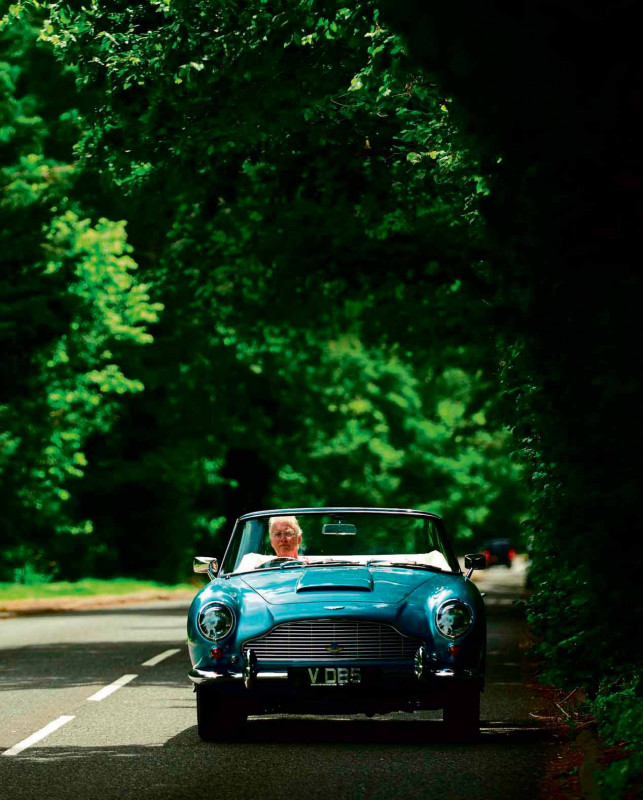
On a pragmatic level, Nick Mee was understandably anxious about exposing £4 million worth of mint-condition Astons to the risk of stone chips (or worse) in the cut and thrust of modern traffic. What’s more, since their completion the cars have barely been driven, and, as with many nut-and-bolt restorations that have then been salted away in dehumidified storage, would benefit from a thorough shakedown and fine-tuning of both their powertrains and their chassis. When Mee & Co find a buyer (or buyers), that’s what they will get before they’re delivered to their new home (or homes).
‘Silver Birch is the obvious choice for a coupé, but Caribbean Pearl is perfect for the Convertible’
Wherever they finish up, let’s hope they’re used and enjoyed. Because, as with cars of any age, they will be all the better for regular exercise. This much was confirmed by the fact that the sweetest to drive of the three was the Convertible – the only one to have covered a meaningful mileage since restoration (and even then we’re talking hundreds rather than thousands of miles).

Left and right The Convertible version of the DB5 was launched in the same year as the coupé but it was a much rarer machine – only 123 were built, of which a mere handful had the Vantage engine. This example looks sensational in Caribbean Pearl over magnolia hides.
So where the Saloon and Shooting Brake fluffed and coughed a bit, the Convertible ran sweet as a nut, pulled with real vigour, and sounded as purposeful and classy as a Weberfed Marek straight-six Aston always should. It really is a wonderful engine in this form – its outputs swelling as the rich, brassy soundtrack reaches its crescendo – and it works beautifully with the sweet-shifting five-speed ZF manual gearbox that’s fitted to all three cars.
Unassisted steering is no great hardship on period-correct tyres, and the disc brakes are more than adequate for this sort of work; only in the suspension department does a period-authentic DB5 really betray its age, as crumbling, pot-holed tarmac sends thumps and shivers through the body.
Unsurprisingly, this is exaggerated in the Convertible, which inevitably – and palpably has the least stiff structure, though the payoff for having no roof is that the sounds of shudders and shakes are carried away in your slipstream. And let’s be honest, you can forgive a car the odd wobble when it looks as gorgeous as this.
And then you come to the DB5 coupé, probably the most iconic Aston of them all, and even if we’ve become a little jaded by constant references to you-know-who, there’s no question that in Silver Birch over black hide, it really does look a million dollars (in fact quite a few dollars more when it’s a Vantage).
Being enclosed within the cockpit focuses the mind – initially on the sublime combination of shapes and materials that make a DB Aston of this period so special, then, once you’re on the move, on the business of making swift progress with economy of effort; slicing the gear lever around its well-oiled gate; nudging the nose into turns with a rock of the shoulders; keeping the throttles clear and the straight-six singing. The Shooting Brake is the real star here, though. I’ve never sat in one before – not many have – so to slip behind the wheel is a genuine privilege. Just one small problem. Where the DB5 saloon has a recessed panel in the rooflining above the front seats to allow extra headroom, the ’Brake does not. Consequently I’m brushing the headlining with the top of my head. Anyone more than 6ft might find it a bit tight in here.
Otherwise it’s all good. The view forward – of the classic Aston dash, its painted metal face inset with those timeless Smiths dials, the long bonnet with its raised wing-tops beyond – is comfortingly familiar. The view in the mirror is anything but. Right at the rear of the cabin are two downward protuberances where the tailgate hinges are cased-in, but otherwise the view of the road behind is so uninterrupted that you’d be forgiven for thinking you’d driven off with the tailgate open.
There was only a little additional weight in the ’Brake compared with the coupé, and the chassis was completely unchanged, so it’s no surprise that the driving experience is essentially the same, although retaining the coupé’s springs and dampers would have limited the loads that could have been transported without serious implications for the handling. Unladen, as it is today, it simply drives like the coupé, but with the added novelty of that remarkable view every time you glance over your left shoulder or in the mirror.
Can you think of a cooler car to transport your family and hampers to the Goodwood Revival? So there you have it: the Saloon as your daily driver, the Convertible for high days and holidays, and the ’Brake for shooting parties, paddock picnics, and trips to the recycling centre. DB5: the model range that does it all.
Thanks to Nicholas Mee&Co, nicholasmee.co.uk


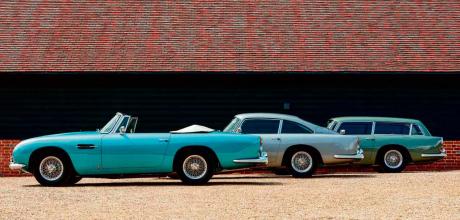
I am glad that Top Gear tested this on their track so that we have a lap time for this great looking James Bond car. This does bring up the point about the use of non-original tires. Obviously they didn't test it on 45 year old tires, and I am pretty certain that the O.E. model tires are no longer made. I would guess they used a similar style and size tire to the O.E. and that is fine. I don't think that it invalidates the test, and thus this does set a precident for equivalent (yet not original) tires when track testing cars that are older or no longer current models. :)
I forgot about «Thunderball» I's been a long time since I've seen an old James Bond movie.
All good things… If you’re a regular reader you’ll know that this is my opportunity to bid you a warm welcome to the latest issue of Vantage. When we launched this magazine back in 2013 we secretly wondered if there would come a time when we simply ran out of things to write about. Once you’ve had a chance to sit down and read it, I hope you’ll agree that this issue proves we needn’t have worried, for the unfolding story of Aston Martin remains as riveting and unpredictable as ever. Sadly it’s a story we won’t be able to share with you, for it is my sad duty to announce that this issue of Vantage will be the last. At least in its present quarterly format. None of you will need reminding how tough the last 18 months or so have been for families and businesses up and down the UK and across the world. Mercifully it would seem the darkest days are behind us, but while Vantage was able to weather the successive waves of Covid-19, the lasting effects of suppressed sales due to the ongoing pandemic have led to some very tough decisions being taken. Vantage has always enjoyed the support of a loyal band of subscribers, but the magazine’s commercial viability also relies upon newsstand sales, the majority of which come from major travel points. With air travel effectively grounded since last March and the shift to working from home reducing footfall in railway stations, trading conditions have been brutal. Needless to say, we are profoundly saddened by the decision, but much like Aston Martin’s ability to bounce back from countless near-disasters, we very much hope Vantage will channel that survival instinct and reappear in some form. Whether you’ve been a reader since the beginning or have just picked up a copy for the first time, we thank you for your support and enthusiasm for a magazine that has been our immense pleasure to produce. Likewise, I’d like to extend our gratitude to our hard-working contributors, the ever-helpful souls at Aston Martin, and the brilliant specialists and generous owners who have been so supportive in providing us with wonderful cars to drive and given us such great tales to tell. We literally couldn’t have done it without you.